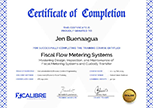| Date | Venue | Fee | |
|---|---|---|---|
| 10 Nov - 14 Nov 2025 | London - UK | $ 5,950 | Register Now |
| 27 Jul - 31 Jul 2026 | Dubai – UAE | $ 5,950 | Register Now |
| 14 Sep - 18 Sep 2026 | Barcelona - Spain | $ 5,950 | Register Now |
| 09 Nov - 13 Nov 2026 | London - UK | $ 5,950 | Register Now |
About the Course
Welding is a high-performance joining technology gaining importance in industry and trades. It is one of the most significant production technologies for many companies operating in the metal-working industry and trades. It is the most common method for permanently joining the sections necessary for building and maintaining petrochemical industry units, pipelines, marine vessels, bridge structures, and many other industrial components.
ASME PVB Section IX is a service/reference code; the requirements of this section apply when referenced by the governing construction code or standard to qualify procedures and personnel. This 5-day interactive ASME BPV Code, Section IX Welding, Brazing, and Fusing Qualifications training course will present the essential characteristics of the standard welding processes and NDT as a basis for understanding the necessary and non-essential variables that are listed for the qualification of procedures and personnel performance. Case studies of welding procedure and personnel performance qualification documentation are also presented to demonstrate how the essential and non-essential variables are identified and documented using the qualification ranges. Finally, a brief discussion and demonstration will be conducted to show how supplementary important variables can be addressed when impact toughness is required by the referencing code/standard or by the delegates.
Core Objectives
The delegates will achieve the following objectives:
- Explain how Section IX is organised and how to locate requirements and paragraphs for welding qualifications
- Understand the welding metallurgy and welding process knowledge that forms the basis for the rules for welding qualifications and personnel performance qualifications
- Know the P# numbers for base metals, F# numbers for consumables and A# for chemical compositions
- Review welding documentation for compliance with Section IX
- Know how to organise and supervise the necessary laboratory tests and interpret the test results
- Determine and confirm welder performance qualifications that are compliant with Section IX
Training Approach
This training course will combine presentations with instructor-guided interactive discussions between delegates about their interests. Practical exercises, video material and case studies to stimulate these discussions and provide maximum benefit to the participants will support the formal presentation sessions. Above all, this programme will extensively use case examples and case studies of issues in which he has been personally involved.
The Attendees
This training course suits many professionals and technicians who deal with oil & gas construction projects and mechanical maintenance works using standard welding processes.
This training course will be valuable to professionals, including (but not limited to) the following:
- Welding Supervisors
- Welding Engineers
- QA/QC Engineers
- Mechanical Engineers
- Inspection Engineers
- Corrosion Engineers
- Production and Maintenance Staff
- Inspectors and Welders
- Staff from Design, Planning and other related Departments
Daily Discussion
DAY ONE: INTRODUCTION TO MECHANICAL PROPERTIES, DT AND JOINT DESIGN
- Engineering Material Properties: Tensile Strength UTS, Ductility, Toughness, Hardness, Creep Resistance & Weldability
- Introduction to Destructive Testing of Materials (DT): Tension Test, Hardness Test, Impact Test, and Bend Test
- Joint Design
- Welding Symbols
- Welding & Testing Positions
DAY TWO: WELDING PROCESSES, DISCONTINUITIES, NDT, AND COMMON HEAT TREATMENTS
- Gas Metal Arc Welding (GMAW)
- Shielded Metal Arc Welding (SMAW)
- Tungsten Inert Gas (GTAW /TIG)
- Flux-Cored Arc Welding (FCAW)
- Submerged Arc welding (SAW)
- Welding Discontinuities
- Visual Inspection (VT)
- Liquid Penetrant Testing (PT)
- Magnetic Particle Testing (MT)
- Radiographic Testing (RT)
- Ultrasonic Testing (UT)
- Preheating & Post Weld Heat Treatment (PWHT) under ASME Construction Codes
- Annealing, Normalising, Quenching, and Tempering
DAY THREE: INTRODUCTION TO ASME IX AND WPS/PQR REVIEW METHODOLOGY
- Parts of ASME IX
- The Relationship of Section IX to Other Codes
- Introduction to ASME II- Part C: Welding Consumables
- Part QG
- PQR Requirements and Testing
- Simple WPS/PQR Review
- Review the Essential and Non-essential Variables
- Qualification Ranges Documented in the WPS
DAY FOUR: REVIEW OF WPS/PQR WITH SUPPLEMENTARY ESSENTIAL VARIABLES
- Review the Supplementary Essential Variables
- Effect of These Variables on Impact Toughness
- Qualification Ranges Documented in the WPS
- Impact Toughness Acceptance Criteria
- WPS/PQR Review with Impact Toughness Requirements
DAY FIVE: REVIEW OF WELDERS/WELDING OPERATORS PERFORMANCE QUALIFICATIONS
- Review the Essential Variables for Welders and Welding Operators
- Test Coupon Requirements
- Qualification ranges documented in the WPQ/WOPQ
- WPQ:
- Single Process Welder
- Multi-process Welder
- Introduction to Brazing Qualification Requirements
- Basics of Plastic Fusing Qualification Requirements
Certificate Awarded
Upon successful completion of this training course, participants will be awarded a Certificate of Completion from XCalibre Training Centre, acknowledging their accomplishment. This certificate serves as a testament to their dedication to developing their skills and advancing their expertise in their respective fields.


